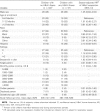Frequent and prolonged shedding of bocavirus in young children attending daycare
- PMID: 20415535
- PMCID: PMC2862123
- DOI: 10.1086/652405
Frequent and prolonged shedding of bocavirus in young children attending daycare
Abstract
Background: Little is known about human bocavirus (HBoV) persistence and shedding and the association between HBoV detection and the onset and resolution of respiratory symptoms.
Methods: We performed HBoV testing on nasal swab samples from a prospective, longitudinal study of respiratory illness in 119 children who attended daycare.
Results: HBoV was detected in 70 children (59%) and in 106 (33%) of the 318 cases of illness. Another virus was detected in 76 (72%) of 106 HBoV-positive cases. Extended and intermittent shedding was observed, with consistent HBoV detection documented for up to 75 days. HBoV was detected in 20 (44%) of 45 asymptomatic enrollment samples, and HBoV prevalence and viral load did not differ significantly between children with and children without symptoms at enrollment. HBoV-positive illnesses were longer than HBoV-negative illnesses (odds ratio for duration of symptoms >7 days, 2.44; 95% confidence interval, 1.41-4.22), and illnesses with HBoV load 4 log(10) copies/mL required a visit to a health care provider more often than did HBoV-negative illnesses (odds ratio, 1.64; 95% confidence interval, 1.02-2.64).
Conclusion: HBoV was more common in illnesses with greater severity. However, detection of HBoV was not associated with the presence of respiratory illness or with specific respiratory symptoms in this prospective study of infants and toddlers attending daycare centers.
Conflict of interest statement
Potential conflicts of interest:J.A.E. and M.P.F. have received research funding from MedImmune. J.A.E. has received research funding from Sanofi Pasteur and Novartis. E.T.M. and D.Z. have received research funding from Vioguard. All other authors: no conflicts.
Figures






Comment in
-
Déjà vu all over again: Koch's postulates and virology in the 21st century.J Infect Dis. 2010 Jun 1;201(11):1611-4. doi: 10.1086/652406. J Infect Dis. 2010. PMID: 20415534 Free PMC article. No abstract available.
-
High prevalence of asymptomatic bocavirus in daycare: is otitis media a confounder?J Infect Dis. 2010 Nov 15;202(10):1617; author reply 1618. doi: 10.1086/656786. J Infect Dis. 2010. PMID: 20955085 No abstract available.
-
Don't forget serum in the diagnosis of human bocavirus infection.J Infect Dis. 2011 Apr 1;203(7):1031-2; author reply 1032-3. doi: 10.1093/infdis/jiq157. J Infect Dis. 2011. PMID: 21402553 No abstract available.
References
-
- Smolinski MS, Hamburg MA, Lederberg J. Microbial threats to health: emergence, detection, and response. Washington, DC: National Academies Press; 2003. Institute of Medicine. Committee on emerging microbial threats to health in the 21st century. - PubMed
-
- Cordell RL, MacDonald JK, Solomon SL, Jackson LA, Boase J. Illnesses and absence due to illness among children attending child care facilities in Seattle-King County, Washington. Pediatrics. 1997;100:850–855. - PubMed
-
- Neuzil KM, Hohlbein C, Zhu Y. Illness among schoolchildren during influenza season: effect on school absenteeism, parental absenteeism from work, and secondary illness in families. Arch Pediatr Adolesc Med. 2002;156:986–991. - PubMed
-
- Kahn JS, Kesebir D, Cotmore SF, et al. Seroepidemiology of human bocavirus defined using recombinant virus-like particles. J Infect Dis. 2008;198:41–50. - PubMed
Publication types
MeSH terms
Grants and funding
LinkOut - more resources
Full Text Sources
Other Literature Sources

